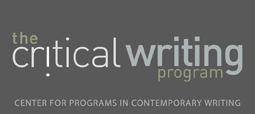An Overview of the Discipline
Art History studies visual and physical materials ranging from what is traditionally defined as art to architecture, landscape architecture, and private objects, whether humble or luxurious. Art historians seek to gain a deeper understanding of human expression and visual language.
Writing in the Discipline
Reasoning
Writing in Art History is largely expository. The ability to critically analyze a work of art, employ period evidence, and consider theoretical models is essential. Writers need to make a close study of the visual material, should try to avoid letting their papers become too "thesis driven," and strive for a thoughtful analysis that explores all perspectives of the work.
Evidence
In Art History, the piece of art work or structure in and of itself is the most important evidence. Scientifically-based techniques, from carbon dating to pigment analysis, may be used to analyze the work. Text-based sources are useful in developing a period context for a work, reconstructing viewership and reception, formulating ideas, and putting the work into a larger disciplinary discussion that addresses critical methodologies.
Authorship
Most scholarly work in the field is single-authored, though there are collaborations across the field. Multi-author volumes increasingly link art and architecture to other disciplines.
Goal
Scholars writing in the field of Art History engage in both critique and problem definition and solution. Dr. Davis describes it as a “sort of mystery story.” As an example, she cited her research on an artist who had been punished and censored for his prints satirizing history. In the process of researching this artist, she discovered that other artists had been similarly disciplined, and her work fundamentally changed what was known about the event. All forms of (art) history are reconstructive, not only those exploring the vanished cultures of the deep past. Dr. Kuttner's original work seeks to expand our knowledge of an object of study. It is often fueled by cross-disciplinary research, finding new comparisons for works that have only been individually studied, and consistently attending to all facets of the monument or artifact ("not just one side of the vase").
Writing Tips for Students
- All art historical analysis begins with a thorough study of the work under discussion. Original ideas (or mastery of others' ideas), solid evidence, logical reasoning and evidence, and thoughtful organization are considered essential. Proper citation of references, grammar, and style are also important.
- In Art History, either prose transitions or subheadings may be used to link different parts of the paper.
- Introductions should aim to delve into the intellectual project of the paper and move beyond simply why the topic at hand is important.
- Conclusions should seek to go beyond a summary of the essay, posing, for instance, additional directions for analysis.
Genre
Student Assignments
Writing assignments in Art History typically consists of research papers, book reviews, response papers about a work or an essay critique, and formal analyses. A formal analysis is a thorough description of the design elements of a piece of artwork or a structure, including color, texture, composition, scale, and other features. Seminars typically require oral presentations about art and/or texts, and brief presentations may be assigned in lecture courses.
Professional Writing
Scholarly genres in Art History include books, articles, exhibition catalogues, museum's online catalogues, book reviews, critiques, and conservation reports among others. Other writing includes tenure reports, letters of recommendation, scripts for podcasts, research talks, radio and television.
Additional Resources
Paul Silvia’s How to Write a Lot
William Germano's Getting it Published
Sylvan Barnet's A Short Guide to Writing About Art
Duzanne Hudson and Nancy Noonan-Morissey's, The Art of Writing About Art
The University of North Carolina at Chapel Hill's handout for art history writing
© 2013-2015 The University of Pennsylvania


